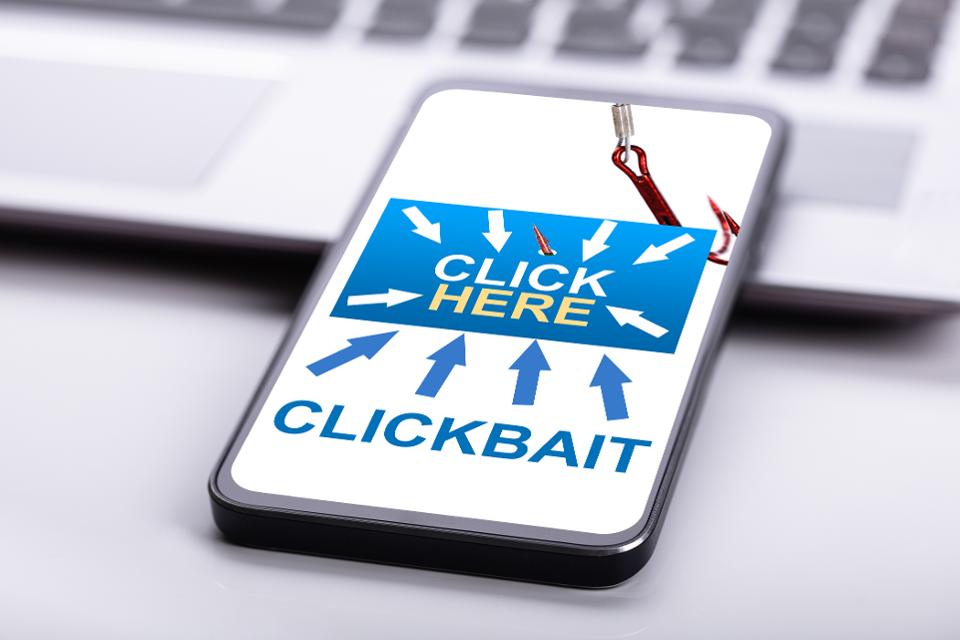Clickbait is often a sensationalized post about trending news items
Getty
The headline above is obviously not true – it included some of the top searched Internet trends at this moment – but unfortunately similar “catchy” headlines on social media are being generated to lure in readers. In some cases it is done to generate web traffic, as in “clickbait.” However, slightly less sensational headlines are used as part of elaborate scams.
Last month the Better Business Bureau sent out a warning to fans of Kobe Byrant that scammers were taking advantage of his tragic death. The BBB offered tips that everyone should already know.
“Clickbait is a sensationalized post about trending news items highlighting exclusive, breaking or urgent news inciting people to quite literally, click on it,” the BBB warned. “The description uses words like ‘amaze,’ ‘shocking’ or ‘never seen before footage.’ Once clicked, the reader is taken to a site that may allow cyber criminals to hijack your account or steal personal information.”
Clickbait Marketing
Today it isn’t just cybercriminals that are utilizing clickbait. Last month, The Columbia Journalism Review lauded The Washington Post for pulling “off the neat trick of combing prestige journalism with a shadow of clickbait factory that puts out a steady flow of fast-turnaround aggregated stories grasping at virality.”
The Post’s stories include snazzy headlines that help tell a story – “Officials said he died in a fall. Then his wife admitted to poisoning his water with eye drops.” More importantly those headlines are ready made to be shared on social media.
Marketers have long seen potential in creating such headlines as a way to share content. Last week in a post on the South African-based Media Update (MU), an article discussed ways that clickbait could be used by a “media agency.”
MU suggested, “It increases the chances of social shares,” and noted that good headlines include emotive words that could be turned into hashtags, and that clickbait is a way to get people to share and talk about content. In many ways this could be seen as just an extension of those colorful newspaper headlines, but is clickbait in fact the best way to accomplish this?
“When we think about clickbait, we need to consider what’s at play and who’s the pawn,” said Josh Crandall, principal analyst at Netpop Research.
“Consumers are responsible for clicking on the story, but is it really their fault?” he pondered. “How can somebody be considered guilty for clicking on a story that has been tee’d up in a tantalizingly lascivious lede? We’re all guilty of that at one time or another. The real question is how do people resist the clickbait found on the Internet today? In my opinion, the only way people do not click is with a dose of good old cynicism mixed with a tad of empathy.”
SEO By Another Name
Anyone who has a website probably has gotten an email from a “Search Engine Optimization” (SEO) firm that promises better search results on Google and other search engines. While many of these companies promise to deliver top search results with savvy tools only they know, most SEO hucksters are simply offering a form of Silicon Snake Oil.
In many cases that oil includes a healthy dose of clickbait, which these firms suggest be spread across social media platforms.
“That’s an old SEO black hat trick that has been around since the early 2000’s used for a slightly different deceitful purpose; to fool the search engines,” said social media consultant Lon Safko, author of The Social Media Bible.
“The technique was used as a headline and buried several times in the content of web pages and when blogs first came on the scene,” Safko added. “Then, it was called ‘trademark sucking.’ It worked then, and still works today because these web designers and bloggers simply look at the top 10 news stories headlines, and pull the most popular keywords, then string them together in a random sentence and embed them on the page. That’s the formula.”
People would read the seemingly outrageous headline, which was filled with plenty of hyperbole, because they wanted it to be read said Safko. “Each word triggers a momentary euphoria. They then clock on the link, quickly realize they’ve been tricked, but still feel that rush. So, they move onto the next rush.”
Combating Clickbait
While the threat remains that clickbait can be part of an elaborate effort to scam people, such as by directing them to a nefarious website, or by fooling individuals into donating to a fake charity – much of clickbait just remains a lure for traffic. As noted, clickbait could be as little as the right choice of words on social media.
Here we shouldn’t blame the readers for clicking on the seemingly compelling headline links, but look at the practice entirely.
“Rather than focusing on the consumer, we should be focusing on the platforms that enable clickbait to be disseminated like never before,” said Crandall. “Social media platforms, sheltered by section 230 of the Communications Decency Act, aren’t responsible for the opinions presented by shady rags and tabloids that concoct the stories that pry on our most subconscious human tendencies.”
It could be argued that readers can avoid being tricked by this technique by a simple method: using common sense.
“When you read a headline that is too sensational, it should set off a warning that says, ‘anything that looks that absurd, is,'” said Safko.
However, Crandall admitted in today’s world, the line between journalism and social media is being blurred more than ever before. “To say that social media platforms are competing just like a traditional media company. But, the rules benefit the social media companies more than traditional media companies, as they are held to a different standard.”

